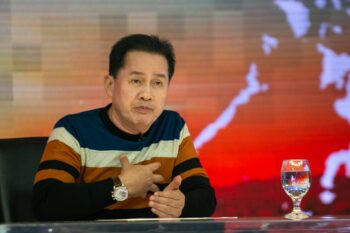GENERAL SANTOS CITY, October 5, 2015 – In the Philippine political system today, political parties are just tokens. This “tokenism” set root when President Ferdinand E. Marcos abolished the two-party system on declaring martial law in 1972. After EDSA I in 1986, the multi-party system was embedded in the 1987 Constitution which, unlike the same system in many countries today, has degenerated into “political party tokenism”.
What do we mean by “political party tokenism”?
“Token” as we use it here is not exactly how the Webster’s Collegiate Dictionary means it although closely synonymous: (1) an outward sign or expression; (2) symbol, emblem; we mean it as “semblance”, as used in the transit system before the magnetic cards. To gain entry into a subway or elevated train, one had to buy a token, resembling a coin.
Flashback
Until the abolition of the two-party system in the Philippines, the majority party ruled. The President belonged to the majority party; in most times, he had the support of the Congress with both the Senate and the House ruled by the majority party. The majority ruled; the minority fiscalized. At times, blocs within the majority joined the fiscalizing.
During elections, the parties nominated their candidates in conventions most preferably from among the loyal members. Party outsiders were considered for nomination after they had been sworn in as party members. The Nacionalista Party “pirated” Ramon Magsaysay and Ferdinand E. Marcos who were top Liberals – Marcos the LP president –to be the NP standard bearers in 1953 and 1965, respectively; they took their oath as Nacionalista members before their nomination in the national NP convention.
After the election, the party winning the majority of the elective positions wielded power; that or those winning the minority provided the check and balance. The minority did not always oppose the majority; but never did they – or any of their members – coalesced with the majority to share power and its bounty.
Is that the case in today’s multiparty system?
Post-EDSA I
Let’s take a look at the trivialization of the political party system since the first post-|EDSA I congressional election in 1987 and the presidential in 1992. Make your own conclusions; to us it’s trivialization to the nth degree rendering meaningless all that political parties stand for.
In the May 11, 1987 senatorial elections 54 candidates were accepted by the Commission on Elections to run registered as members of eight political parties or as Independent. Only five campaigned as KBLs (Kilusang Bagong Lipunan); one, Independent. The 48 others formed two coalition tickets, LABAN and GAD (Grand Alliance for Democracy). None of the political parties was so organized as to nominate candidates and support their election. The candidates nominated themselves carrying their parties to ride on.
LABAN, short for Laban ng Demoratikong Pilipino, the party of the late Sen. Benigno “Ninoy” Aquino Jr., was composed of nine LPs, one Independent, nine UNIDOs, three PDP-Labans, one NUCD and one BANDILA. They were supporters of President Cory Aquino, who ran under UNIDO in the 1986 snap election against Marcos for LABAN had not been registered with the Comelec. After LABAN had been registered, the coalition became LDP.
GAD was composed of eight NPs, 13 LBLs, two Independents, three UNIDOs and one Muslim Federal Party. They were an aggrupation of Marcos loyalists and pro-Cory Aquino leaders who could not be accommodated in the LABAN. Only two from the GAD — NPs, Estrada and Juan Ponce Enrile – won; they were Cory allies.
The KBL and UNIDO only gave the 1986 presidential snap election a semblance of an election between two parties. In reality, the parties were just “tokens” used by two dominant persons. Both the martial law regime and the Cory Aquino government were not rules by party but by person. The LABAN victory in 1986 was not a party victory but that of President Cory Aquino. There was no “party system” to speak of; just the coalition of members of different parties to be and to stay in power.
Truth Unravelling
This truth unraveled in the 1992 presidential election. The coalitions broke up to form new coalitions to entrench the “coalition system” and “political party tokenism”.
President Cory Aquino refused to run for election although she was not covered by the six-year constitutional term limit. Five of the nine presidential candidates were under her ruling coalition and ran under different parties – Vice President Salvador Laurel (NP), Senate President Jovito Salonga (LP), Speaker Ramon Mitra (LDP), Defense Secretary Fidel V. Ramos (Lakas); and Agrarian Reform Secretary Miriam Defensor-Santiago (PRP – People’s Reform Party which she founded as her political token).
Where was the political party system to properly speak of? Had there been real party rule under President Cory Aquino only one of the five should have been nominated by the ruling party. Cory, in fact, anointed and supported Ramos as her successor.
The coalition system around the sitting president who anointed his or her successor has prevailed as the standard political practice in post-Marcos Philippine politics. With the failure of the pre-martial law NP and LP to regain their true political party status and the mushrooming of new personalized parties, the coalition system and political party tokenism have prevailed in all the elections until 2013 and will prevail in perpetuity.
Let’s note well how the coalition system reshaped in the three presidential elections after 1992 and see how, together with political party tokenism, it will prevail in the May 2016 presidential election.
In 1998, Estrada (LAAMP), Jose de Venecia (Lakas), Gloria Macapagal-Arroyo (Kampi) and Edgardo Angara (LDP) initially filed their candidacies for president. Of the four, Estrada and Arroyo were very popular. To ride on popularity, Angara coalesced with Estrada sliding down to the vice presidency; Arroyo, to avoid clashing with Estrada, coalesced with De Venecia as his running mate. Angara and De Venecia both lost.
In 2004 and 2010, leading presidential candidates all ran under coalition tickets. In 2004, Noli de Castro (Independent) allied with Arroyo as running mate. In 2010, two vice presidential candidates were guest running mates – Jejomar Binay, of Estrada; Loren Legarda, of Manny Villar. Like presidential and vice presidential candidates, senatorial candidates ran in coalition tickets – nominated by themselves, not by their parties.
What’s Up Ahead?
Against this backdrop, we will see what is shaping up for the 2016 presidential election. What do the 2010 and 2013 elections tell about party system, party rule, coalition system and political party tokenism?
In the 2010 election, Sen. Benigno Simeon C. Aquino III won the presidency with 42.08 percent of the 38,149,31 votes cast – the biggest landslide compared to Arroyo’s 39.99 percent (33,510,092 ) in 2004 and Estrada’s 39.86 percent (29,285,775) in 1998. He was the Liberal Party standard bearer.
Was that a victory of the Liberal Party? The tale of the 2010 general elections must not be glossed over. Aquino’s running mate, Manuel A. Roxas III, LP president, lost; only three LPs in a senate line-up of 10 Liberals and two Independents won; and, only 45 LPs won seats in the House of Representatives against 107 Lakas (Arroyo’s) out of 287 seats.
Aquino III’s triumph was Aquino political victory, not the Liberal Party’s. He was carried by the Cory (his mother) charisma, not by the strength of the Liberal Party. The six-year Aquino administration is the Aquino rule not LP rule.
To govern, Aquino did not tamper with the Senate leadership under Senate President Juan Ponce Enrile (PMP); however, the Enrile Senate deferred to Aquino. In the House, the Lakas representatives either defected to the LP or joined the LP-led coalition. To survive politically and to share power and bounty, other members of the House readily joined the LP-led coalition without shedding off their political identities. That’s party tokenism.
The 2013 midterm election showed clearly that the coalition system and party tokenism have taken over the Philippine politics. For the Senate, the candidates registered with their party affiliations but ran under the Team PNoy, the administration coalition, or under United Nationalist Alliance (UNA), the primary opposition coalition. Team PNoy won nine seats with only one LP; two other LPs and the lone Party-list lost.
In the House, the LPs won 114 of the 292 seats – 33 short of the 147 majority. The coalition system prevailing, the LP-led administration coalition numbers more than 170 held together not by LP rule but by the Aquino rule – the non-LP coalition members riding with their party IDs on to continue sharing power and bounty (party tokenism).
Will the LP-led administration coalition behind the Aquino III rule support the bid of the Liberal Party to continue the Aquino III rule?
Trade and Bargaining
The LP-led coalition, particularly Team PNoy in the Senate, has broken up. The coalition is made up of LPs, NPs, NPC, PDP-Laban and Independents. Sen. Grace Poe rejected the LP overture for her to run as Roxas’ running mate. Riding on high poll survey rating, she declared her presidential candidacy with fellow Independent Sen. Francis Escudero as her running mate. Three other NP senators — Allan Peter Cayetano and Antonio Trillanes III and Ferdinand R. Marcos Jr. – have, by themselves, declared their vice presidential bids.
Poe and Escudero have no party. By political trade, with Poe’s “winnability” boosted by poll surveys for bargaining, a political party (the NPC and NUP are prospects) will soon give the Poe-Escudero tandem a political wagon for them all to hitch on to Malacanang. Should Poe win, she will have no need for party; she can wield personal rule through the coalition system and party tokenism.
On their own, Cayetano, Trillanes and Marcos are shopping for presidential wagons to hitch on; finding none, they will run alone but support the strongest presidential candidate to insure political survival when they lose – quite a certain eventuality. Unfortunately, none of them is a Noli de Castro whose popularity propelled him on top of the 2001 senatorial election as Independent; running on the same status for vice president in 2004, he was invited and agreed to ally with Arroyo [Lakas-(K-4)] virtually on his own terms.
The Liberal Party is the only one that has kept the semblance of the party that rules. As LP titular head, Aquino nominated Roxas the LP standard bearer which the LP National Directorate officially confirmed last September 30. The Directorate, however, nominated only four senatorial candidates and left it to Roxas to pick the other eight. The search for a running mate ended as reported today; Rep. Leni Robredo has accepted the post. Why were all these not done in a national party convention proper to the party that rules?
Vice President Jejomar Binay was the first to announce his presidential bid under the UNA. Whether UNA is still a primary opposition coalition or already a duly registered political party is not clear. All we know is that Binay, as PDP-Laban chairman, coalesced with LAAMP of Joseph Estrada to form UNA. Sen. Aquilino Pimentel III, PDP-Laban president, is a Team Pinoy senator. Binay resigned from PDP-Laban last year and the party left UNA. It has been reported that Estrada is not supporting Binay.
But despite the political vagueness, Binay and UNA enjoy strong political support. Until Poe had dislodged him from the top of poll surveys, he had gained strong following for his presidential bid. Never rule him and UNA out of contention for Malacanang. While UNA still has to come out with its senatorial slate, the search for a running mate ended with UNA Sen. Gregorio Honasan fitting in, as also reported today.
Recapitulation
Political trade and bargaining abetted by poll surveys have completely taken over party conventions as the mode of nominating candidates. Ambitious politicians nominate and proclaim themselves and do political trade and bargaining.
The coalition system will prevail with token party rule. Poll surveys have usurped the party prerogative to nominate presidential candidates. Most if not all our pre-Marcos presidents asserted personal power; but they deferred to party rule. With the demise of party rule after EDSA I, personal rule will prevail under the coalition system nurtured by party tokenism. (“Comment” is Mr. Patricio P. Diaz’ column for MindaViews, the opinion section of MindaNews. The Titus Brandsma Media Awards honored Mr. Diaz with a “Lifetime Achievement Award” for his “commitment to education and public information to Mindanawons as Journalist, Educator and Peace Advocate.”)







